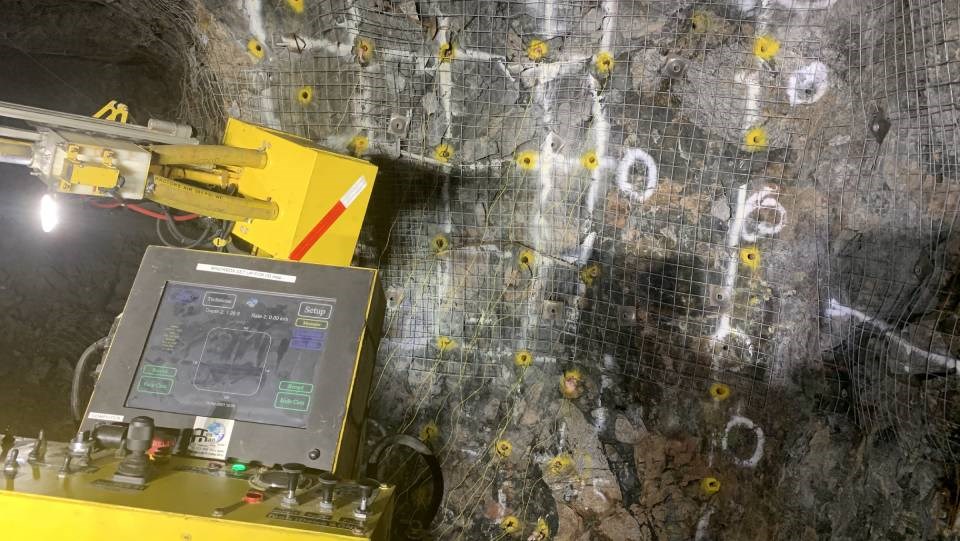Clara and Rod Steele have been developing their robotic explosives-loading arm for the mining industry for nearly a decade, but as they inched closer to commercialization, they realized they needed help to push it that last stretch to market.
So, in early 2020, they assembled a group of mining companies, equipment fabricators, an explosives manufacturer, and engineering firms into a unique consortium to harness their wealth of expertise.
“As we went along, we had to get more energy in the team, because we're a small team and we're only learning to do one piece. So we needed to get other people involved to do the other pieces better,” said Rod, who co-owns Sudbury-based TesMan with Clara.
“We reached out to the companies that we had developed confidence in, and they all jumped in.”
The Steeles' remote loader can load, wire and fire blast holes at the face while the operator remains safely in the vehicle's cab five metres back from the high-risk zone.
The arm can be attached to any underground utility vehicle, and it's operated via a screen set up in the cab.
Sign up for the Sudbury Mining Solutions weekly newsletter here.
Workers can be fully trained in its operation within about two or three shifts, Clara said, and maintenance on the plug-and-play units is minimal. If one module goes down, TesMan will swap it out with a new one.
“We tried to keep it as simple as possible, we tried to keep it as low capital as possible, and we try and use what the mines already have in place now,” Clara said.
“We can just retrofit equipment that they already have sitting underground to keep the capital expenditure as low as possible.”
Until now, the Steeles had ferried the idea from concept, through proof of concept, to use in production. But the consortium helped them complete production testing with bulk emulsion.
The mining companies KGHM, Rocklciff Metals Corp. and Vale came on board, as did equipment manufacturers Komatsu, Kovaterra and Quatro.
Dyno Nobel provided the explosives expertise, and from the engineering end of things, the Steeles recruited CEMI, Technica Mining and Stantec.
Together, they comprised what Rod colloquially calls ‘Team Load-Wire-Fire.’
Sign up for the Sudbury Mining Solutions weekly newsletter here.
Over the last year, they put the robotic arm through its paces, engaging it to perform multiple, repeated tasks to prove up the technology, tweaking it where required.
Rod said testing was done at KGHM's McCreedy West Mine, while Technica provided two operators, who gave invaluable feedback on the equipment.
In their trials, the team discovered that not only does the equipment improve safety by keeping workers back from the face, but it also increases productivity.
Rod said the consortium is in the process of fine-tuning the business case, but preliminary numbers show that the technology can help shorten the entire mining cycle by up to 40 per cent.
“That's in a single face; that's not multiple faces where you can spread activities or multiple faces where you can put lots of people. It's not modified like that,” Rod said.
“It's the raw, pure round of activity to move a single face heading ahead, which is then scalable to multiple faces.”
Now, the arm is ready for its debut on the commercial market.
In late June, the company posted to its website a series of videos demonstrating the robotic arm at work, and already a handful of companies have expressed interest.
Clara acknowledges it can be difficult for mining companies to adopt new technologies. Yet TesMan believes the benefits in time and money saved, along with safety, are invaluable.
“Mining is going deeper; it's where the ore is, so it's much more expensive, it's much more seismic, and it's much more dangerous,” she said.
“So mines are going to have to come up with ways to save money and keep their mines safer, and if they can do it in a faster way, then that's a benefit to everyone.”
While the remote loader rolls out to market, the Steeles are already working to advance the technology to its next logical step: teleremote operation.
That would allow operators to use the equipment from outside the tunnel, while recovering more ore and shortening the mining cycle further.
TesMan is finishing the proof-of-concept tests on the loader's teleremote modules and support vision systems. Underground testing should take place in the first quarter of 2022.
Until teleremote operation becomes a reality, however, the Steeles believe their mechanized remote loader offers a helpful solution in bridging companies between old-school methodology and new.
"The mining companies are excited that they can see that this necessary road is going to be doable, and maybe with a Northern Ontario solution it's a path that mines are going to have to take in order to be sustainable,” Clara said.
“So we're really happy with the feedback we've had so far, and we're just excited to get our first client and get rolling."
The Drift features profiles on the people, companies and institutions making important contributions to Greater Sudbury’s mining sector. From exploration, operation and remediation to research and innovation, this series covers the breadth of mining-related expertise that was born out of one of the world’s richest mining camps and is now exported around the world.
– Sudbury Mining Solutions




